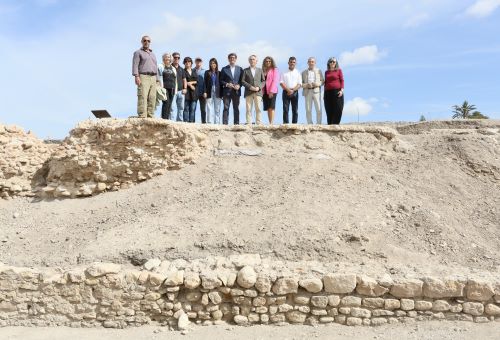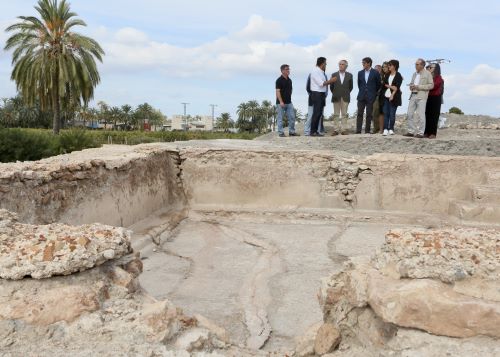
The archaeological works at La Alcudia carried out during the 19th MARQ Excavations and Research Campaign have taken a further step towards the recovery and enhancement of the Western Thermal Baths of Illici.
The Provincial Council and the University of Alicante have pushed for this emergency plan for the archaeological documentation and diagnosis of structural damage of the exterior front of the historic complex, which was visited this morning by the deputy for Culture, Juan de Dios Navarroand the councillor for Culture of Elche, Irene Ruiz, accompanied by the vice-rector for Research and acting rector of the UA, Juan Moraand the director of the Institute for Research in Archaeology and Historical Heritage (INAPH), Carolina Doménech.
The objectives of this Emergency Plan have focused on the analysis, evaluation and diagnosis of the structures belonging to a monumental thermal complex from the Roman period located on the western front of the site, the site of the ancient Colonia Iulia Ilici AugustaThe aim of the project is to draw up a technical document that will enable it to be subsequently consolidation, restoration and integral enhancement.
The director of MARQ, Manuel Olcinahas been in charge of the work together with the director of Architecture of the provincial institution, Rafael Pérezas well as Mercedes Tendero y Ana Mª RondaThe project is being carried out by the Archaeology and Cataloguing departments of the Fundación Universitaria La Alcudia, respectively. The results of the intervention, which lasted five weeks, have confirmed the monumentality of these Roman bathswhich exceed 1,500 square metresThe exponential erosion suffered by the structures of which it is composed, in a continuous process of deterioration due to the loss of elements, fractures and alterations that threaten the definitive collapse of some walls and pavements.
All of this work together has been added to the textual and graphic documentation collected over the last 25 years by the La Alcudia Foundation.This technical information allows for the monitoring and evaluation of the alterations, incidents and progressive pathologies in the state of conservation of this building located next to the main entrance to the site.
As Olcina explained, the work carried out this year has focused on the manual cleaning of the vegetation cover and agricultural soil that covered the original factory. The weight of topsoil that affected a good stretch of a concrete floor paving a large arena has also been relieved.
The walls, pavements and remains of architectural structures of these thermal baths analysed have been processed by the topography and photogrammetry services using drone flights, laser scanners, point clouds, etc., tasks that allow all the documentation collected to be computerised and vectorised in order to analyse their components, their state of conservation, diagnosis, stratigraphic relationships and to locate reference points that allow future monitoring of possible displacements of the existing constructive elements.
Similarly, the following have been carried out FRAC files (Fichas de Restauración Arquitectónica y Conservación), which contain the descriptive documentation and the proposals for urgent intervention for the stabilisation and protection of the set of constructive remains which, in the end, will be the basis for the drafting of a report on the viability of recovering the thermal complex studied.

